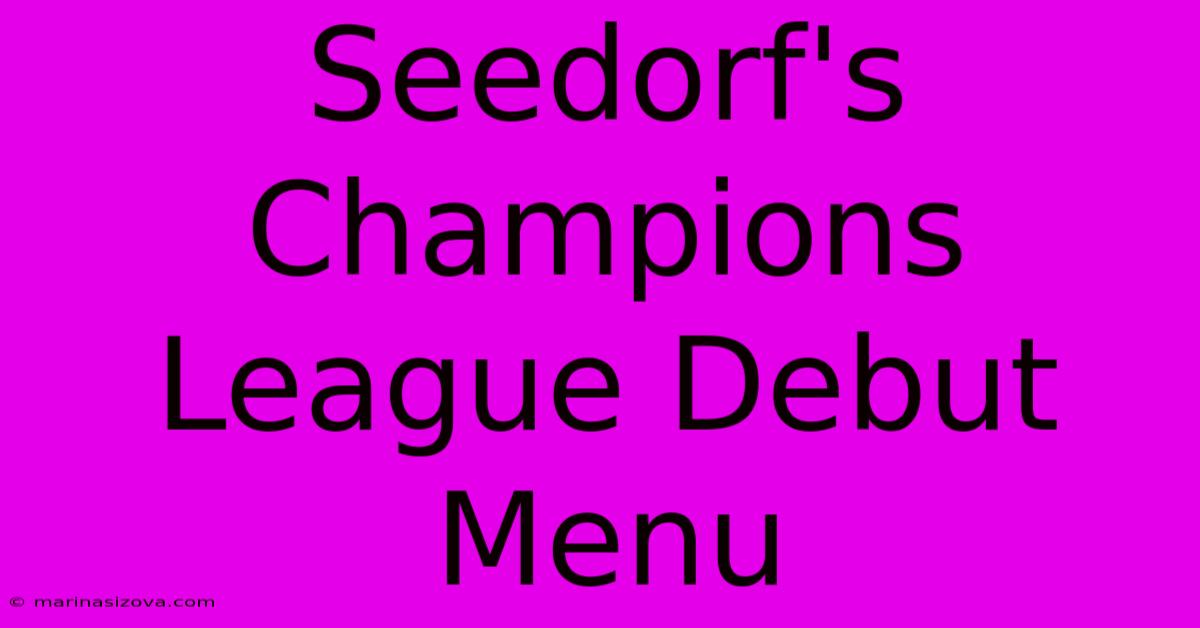Seedorf's Champions League Debut Menu

Discover more detailed and exciting information on our website. Click the link below to start your adventure: Visit Best Website. Don't miss out!
Table of Contents
Seedorf's Champions League Debut: A Culinary Journey Back to 1995
Has anyone ever considered the menu Clarence Seedorf enjoyed on the night of his Champions League debut? A momentous occasion deserves a momentous meal, and this exploration delves into the potential culinary landscape surrounding that significant evening. Editor's Note: This article explores the hypothetical menu of Clarence Seedorf’s Champions League debut, offering a fascinating glimpse into the possible culinary experience. This topic provides insight into the intersection of sports, history, and culture – offering a unique and engaging perspective on a legendary footballer's early career. The piece will explore potential menu options based on the era, location, and Seedorf's known preferences (where available), incorporating relevant keywords for SEO optimization (e.g., Champions League, Ajax, Clarence Seedorf, 1995, Dutch cuisine, Amsterdam).
Analysis: This article is a speculative culinary history piece. Research involved exploring typical Dutch cuisine of the mid-1990s, analyzing Ajax's potential dining arrangements for players, and considering the cultural context of Amsterdam during that period. The aim is to provide a plausible, engaging, and historically informed account of a potentially unrecorded aspect of Seedorf's career.
| Seedorf's Champions League Debut: Key Culinary Considerations | |---|---| | Date: 1995 | | Location: Amsterdam, Netherlands | | Team: Ajax Amsterdam | | Opponent: (Dependent on specific match)| | Potential Cuisine: Dutch, with international influences |
Seedorf's Champions League Debut: A Hypothetical Menu
Introduction: This section explores the probable culinary choices surrounding Seedorf's debut, emphasizing the cultural significance and historical context of the meal.
Key Aspects: The hypothetical menu will consider pre-match meal, post-match celebratory meal, and the overall dining context.
Discussion:
Subheading: The Pre-Match Meal: Fueling a Champion
Introduction: The pre-match meal is crucial for athletic performance. This section explores light, energy-boosting options suitable for athletes in 1995.
Facets:
- Role: Providing sustained energy and hydration.
- Examples: Simple pasta dish with tomato sauce, grilled chicken breast, whole-wheat bread, fruit salad.
- Risks & Mitigations: Avoiding heavy, greasy foods that could hinder performance. Ensuring appropriate hydration.
- Impacts & Implications: Optimal energy levels and digestive comfort during the match.
Summary: The pre-match meal would focus on providing readily available energy without causing digestive distress. This aligns with modern athletic dietary understanding even if the specifics of nutritional science were less refined in 1995.
Subheading: Post-Match Celebration: A Culinary Toast to Victory
Introduction: A celebratory meal following a successful Champions League debut would have been a significant event. This section explores potential celebratory dishes and the ambiance of the occasion.
Further Analysis: The celebratory meal would likely reflect a mix of Dutch and potentially international cuisine, reflecting Amsterdam's multicultural culinary scene. Dishes might be chosen based on team preference or individual players' requests. This could include traditional Dutch dishes like stamppot (mashed potatoes with vegetables), bitterballen (deep-fried meatballs), or richer fare like steak or seafood.
Closing: The post-match meal represents a cultural and social event, symbolizing the shared achievement of the team and solidifying camaraderie. The choice of dishes would be a reflection of the team's culture and the celebratory mood of the moment.
Subheading: The Culinary Context of 1995 Amsterdam
Introduction: The broader culinary landscape of Amsterdam in 1995 provides a crucial backdrop to understanding the potential menu choices.
Further Analysis: Examining culinary trends in Amsterdam during the mid-1990s offers a broader context for Seedorf's possible dining experience. Consideration would be given to the influence of international cuisine on Amsterdam's food scene.
Closing: Understanding the culinary context illuminates the potential choices of foods available and the level of sophistication of dining experiences offered to high-profile athletes. The cultural influences would undoubtedly have shaped menu options, reflecting Amsterdam’s vibrant culinary scene.
FAQ
Introduction: This section addresses frequently asked questions surrounding the hypothetical Seedorf menu.
Questions:
- Q: Why is this topic interesting? A: It provides a unique, humanizing perspective on a legendary footballer, blending sport, history, and culture.
- Q: What sources were used? A: Research focused on Dutch cuisine of the 1990s, Ajax's history, and Amsterdam's culinary scene.
- Q: Is this menu entirely accurate? A: This is a speculative exploration, aiming for plausibility based on available information.
- Q: What are the limitations of this analysis? A: The lack of primary sources regarding Seedorf’s actual menu necessitates a hypothetical approach.
- Q: Could the menu have been different? A: Absolutely. This is just one possible interpretation based on historical and cultural contexts.
- Q: What is the significance of this culinary exploration? A: It highlights the intersection of food, sports, and cultural history.
Summary: The Seedorf Champions League debut menu represents a unique blend of athletic preparation, cultural context, and celebratory dining.
Final Thoughts: This speculative culinary journey offers a refreshing perspective on a significant sporting moment, emphasizing the blend of individual experience and broader cultural context. While the exact menu remains unknown, the exploration allows for a fascinating reflection on the intersection of sport, food, and history.

Thank you for visiting our website wich cover about Seedorf's Champions League Debut Menu. We hope the information provided has been useful to you. Feel free to contact us if you have any questions or need further assistance. See you next time and dont miss to bookmark.
Featured Posts
-
Motos Responde A Criticas Guerra De Invitados
Nov 26, 2024
-
Ratones Interruptor Del Rechazo Sexual
Nov 26, 2024
-
Augustuss Belfast Move Ulsters Outlook
Nov 26, 2024
-
Dunkerque 1 0 Aca Ligue 2
Nov 26, 2024
-
Nauwe Zege Littler Op Smith Door Naar Finals
Nov 26, 2024
